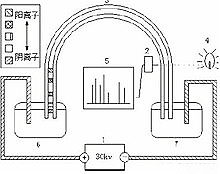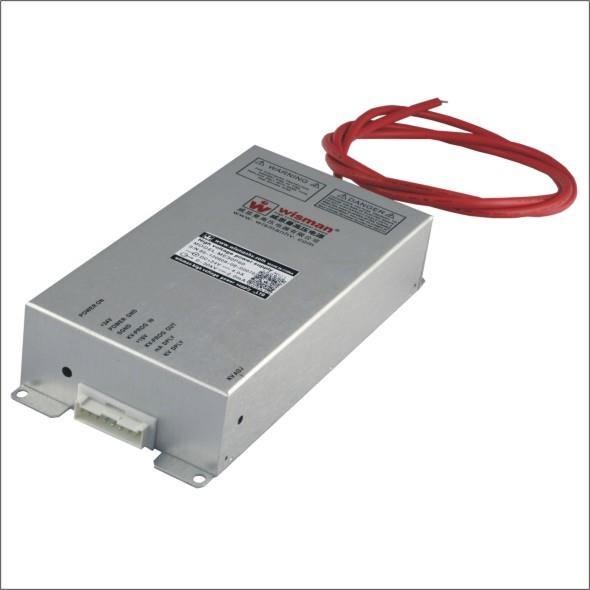Capillary electrophoresis (CE) is also known as high performance capillary electrophoresis (HPCE), is a new type of liquid phase separation technology that takes capillary as the split channel and is driven by high electrostatic voltage field. Actually, capillary electrophoresis includes electrophoresis, chromatography, and their intersection. It enables analytical chemistry to move from the microliter level to the nanoliter level, and enables single-cell analysis and even single-molecule analysis to be possible. The electric double layer refers to the ionic layer with the opposite sign from the surface composed of two relatively fixed and free ions on the separation surface between the two phases. Any interface immersed in the liquid will produce an electric double layer. In capillary electrophoresis, both the surface of charged particles and the surface of the capillary tube wall have an electric double layer.

I. Classification of Capillary Electrophoresis:
Type | Abberviation | Description | |
Single capillary | Capillary zone electrophoresis
| CZE | The capillary and the electrode cell are filled with the same buffer. |
Capillary isotachophoresis | CITP | Use two different CZE buffer solution. | |
Capillary isoelectric focusing | CIEF | The pH gradient medium is installed in the tube, which is equivalent to the pH gradient CZE. | |
Micellar electrokinetic capillary chromatography | MECC | Add one or more micelles to CZE buffer. | |
Microemulsion capillary electrokinetic chromatography | MEEKC | Add oil-in-water emulsion polymer ion exchange in CZE buffer. | |
Electrokinetic capillary chromatography | PICEC | Add microscopically separable macromolecular ions to CZE buffer. | |
Open tube capillary electrochromatography | OTCEC | Use stationary phase-coated capillaries to separate forward and reverse phases for ion exchange. | |
Affinity capillary electrophoresis | ACE | Add affinity reagent to CZE buffer or tube | |
Non-colloidal capillary electrophoresis | NGCE | Add macromolecules to CZE buffer to form a sieving network. | |
Single filled tube | Capillary gel electrophoresis | CGE | Fill the tube with gel medium with CZE buffer. |
Polyacrylamide capillary gel electrophoresis | PA- CGE | Tube filled with polyacrylamide gel | |
Agarose capillary gel electrophoresis | Agar- CGE | Tube filled with agarose gel. | |
Packed capillary electrochromatography | PCCEC | The capillary is filled with chromatographic packing, which can be divided into positive and reverse phases, ion exchange, etc. | |
3. | Array capillary electrophoresis | CAE | CE operation was performed with more than one capillary. |
4. | Microchip capillary electrophoresis | CCE | Electrophoresis is performed using capillary channels carved on a slide. |
5.Combination | Capillary electrophoresis mass spectrometry | CE/MS | Commonly used electrospray interface, requires volatile buffer. |
Capillary electrophoresis/ Nuclear magnetic resonance | CE/NMR | Determination methods that require a paused scan of sample peaks. | |
Capillary electrophoresis/laser-induced fluorescence | CE/LIF | Analysis of the potential for single-cell, single-molecule. |
The high separation performance and low consumption of reagents of capillary electrophoresis technology make it widely used in the field of analysis. Sample preparation techniques can increase sample throughput or pre-concentrate trace analytes and remove sample matrix. Combining it with capillary electrophoresis techniques not only improves analytical sensitivity, but also eliminates most possible matrix interferences. It is an ideal enrichment separation detection technology. Commonly used are CE-flow injection combined technology, solid-phase extraction-CE combined technology, solid-phase microextraction-CE combined technology, liquid-phase microextraction-CE combined technology, microdialysis-CE combined technology and membrane extraction. -CE combined technology.
II. Influencing factors
The selection of buffer reagents is mainly determined by the required pH. At the same pH, the separation effects of different buffer reagents are not the same, and some may be quite different. Commonly used buffer reagents in CE are: phosphate, borax or boric acid, acetate, etc.
2.pH value
The pH selection of the buffer system depends on the nature of the sample and the separation efficiency, and is a key factor in determining the success or failure of the separation. Different samples require different pH separation conditions. To control the pH value of the buffer system, generally only the size of the electroosmotic flow can be changed. pH can affect the dissociation ability of the sample. The dissociation degree of the sample increases in a highly polar medium, and the electrophoresis speed also increases, thereby affecting the separation selectivity and separation sensitivity. pH also affects the degree of protonation of silanol groups on the inner wall of the capillary and the chemical stability of solutes. When the pH is between 4 and 10, the degree of dissociation of silanol groups increases with the increase of pH, and the electroosmotic flow also increases. high. Therefore, pH is a factor that cannot be ignored when optimizing separation conditions.
3.Separation voltage
In CE, the separation voltage is also an important parameter to control electroosmosis. High voltage is the premise to achieve fast and efficient CE. The higher the voltage, the greater the migration of the sample and the shorter the analysis time. However, the Joule heat in the capillary increases, the baseline stability decreases, and the sensitivity decreases; the lower the separation voltage, the better the separation effect. , the analysis time is prolonged, the peak shape is broadened, and the separation efficiency is reduced. Therefore, a relatively high separation voltage will improve the resolution and shorten the analysis time, but too high a voltage will broaden the spectral band and reduce the separation efficiency. At the same electrolyte concentration, the current value and Joule heat in the non-aqueous medium are much smaller than those in the aqueous medium, thus allowing the use of higher separation voltages in the non-aqueous medium.
Temperature affects separation reproducibility and separation efficiency, and controlling temperature can control the size of electroosmotic flow. When the temperature increases, the viscosity of the buffer solution decreases, the dissociation ability of the silicon light radical on the tube wall increases, the electroosmotic speed increases, the analysis time is shortened, and the analysis efficiency is improved. However, if the temperature is too high, the radial temperature difference in the capillary column will increase, the Joule heating effect will increase, the column efficiency will decrease, and the separation efficiency will also decrease.
5.Additive
The addition of additives, such as neutral salts, zwitterions, surfactants, and organic solvents, to the electrolyte solution can cause significant changes in electroosmotic flow. Surfactants are often used as modifiers of electroosmotic flow, and the magnitude and direction of electroosmotic flow can be controlled by changing the concentration, but when the concentration of surfactant is higher than the critical micelle concentration, micelles will be formed.
There are two conventional injection methods for CE: hydrodynamic and electromigration injection. Electromigration injection is under the action of an electric field, relying on the electromigration and/or electroosmotic flow of sample ions to inject the sample, so it will cause electrical discrimination, which will reduce the accuracy and reliability of the analysis, but this method is especially suitable for viscosity. Large buffer and CGE cases.
Wisman can provide the high stability and low ripple high voltage power suppler for a full range of capillary electrophoresis.
The feature of the full range of DNA products.
DC/DC the output voltage reach to 30kv, output power to 5w,10w even 20w. While ripple wave and noise less than 3mV P-P, there is no micro discharge. The high stability is 10ppm per hour, every 8 hour can reach to 20ppm and 1000 hour reach to 100pm. Low temperature coefficient is 10ppm per degree celsius. The protection of spark and short circuit remain it. External potentiometer or external control voltage is specified, RS-232,RS-485 are available. The network port control, address is configurable, small addressable size and mental case with six sides shielding so it enjoys strong anti-interference.The output of positive electrode or negative provides OEM customization.

The feature of the full range of PMC products.
DC/DC the output voltage reach to 30kv, output power to 20w. While,ripple wave and noise less than 2ppm.The high stability is 0.005% per hour,every 8 hour can reach to 0.01% and 1000 hour reach to 0.05%.TC10 is available,high stability is 0.001% per hour,every 8 hour is 0.002% and 1000 hour is 0.01%.Low temperature coefficient is 25ppm per degree celsius and 10ppm is available.External potentiometer or external control voltage is specified, RS-232,RS-485 are available. The network port control, address is configurable, small addressable size and mental case with six sides shielding so it enjoys strong anti-interference.The output of positive electrode or negative provides OEM customization.

More detailed information about high voltage products of Wisman,call 086-029033693480 or visit its website www.pailking.com














